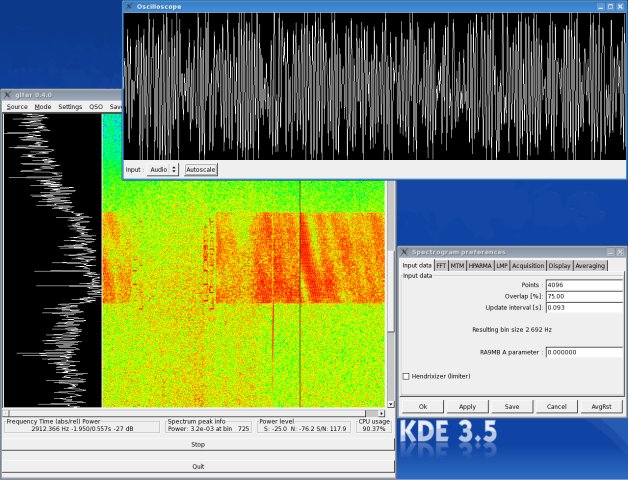IN3OTD's web site
...under perpetual construction.

glfer
glfer is a GTK+ application with a waterfall spectrum display and slow CW (QRSS) / dual-frequency CW (DFCW) transmitter control interface. It's composed of two main parts:
- the spectrogram window, where you can see the spectrum of the received signal vs. time
- the transmission functions, to emit cw characters at a slow but precisely controlled speed, using the QRSS (slow CW) or DFCW (Dual Frequency CW) modes
The signal to be analyzed can be acquired in real-time from the sound card or can be read from a WAV file.
Starting from release 0.3, it is possible to select a spectral estimator among several different types:
- the "classical" periodogram, which is obtained as the modulus square of the discrete Fourier transform, after tapering the data with a "window function" selectable among the Hanning, Blackman, Gaussian, Welch, Bartlett, Rectangular, Hamming and Kaiser types,
- the multitaper method, which is a weighted combination of periodograms computed with different windows, all belonging to the same family and having certain peculiar properties [1].
This method requires more CPU power than the first one, due to the fact that several FFTs are performed on the same block of data, using different windows. The resulting spectrum is similar to a classical periodogram, but with much less variance (i.e. less variation in the background noise [speckle]). Performances are also similar to the periodogram, maybe it makes detection of QRSS signals a little easier, but this doesn't means they are always more readable. - a (so called) "high performance" ARMA model, which assumes a certain model for the input data (in this case it assumes white noise plus sinusoids) and tries to extract the parameters of this model (sinusoids frequency and strength) from the data [2]. The number of sinusoids is estimated automatically from the samples autocorrelation.
Unfortunately this spectral estimator performs poorly when the noise spectrum is not flat (as it is usually in the RX audio, due to the IF filters) and when the signal-to-noise ratio (SNR) is low. On the other hand it provides a very good visual SNR with signals not buried in the noise... I will try different related methods in the future, in the hope of finding one really useful for digging weak signals out of noise. - a new LMP estimator (details to follow)
The spectrogram window includes also an Automatic Gain Control, which allow the output spectrogram to cover the entire palette to ensure the maximum visual contrast. In addition to this, there is also an automatic limiter which can be enabled to try to enhance the signal detection (based on an idea of RA9MB).
When using FFTW (see below) the number of points per FFT is not restricted to powers of two and is anyway user selectable up to about 65536 points. This limitations is mainly due to the maximum window size and could be (easily, or at least I think so) removed in the future. The sound card sampling rate is selectable to values depending on the capability of your particular hardware. For easier reading of the signals frequencies, you can automatically add an offset, with the usual convention of negative offsets meaning LSB reception.
The transmitter can be controlled using the serial or the parallel port; the pins used for PTT and key are the same as in Rik Strobbe QRS, i.e. RTS = key and DTR = PTT/DFCW for the serial port, DB0 = key, DB1 = PTT/DFCW for the parallel port.
A more detailed description is in the README file included in the glfer source distribution.
Here is a screenshot of glfer (click on the picture for a larger image [350 kB]):
glfer is written using the GTK+ library (version > 2.0) for the graphical user interfaces, so please make sure that it is already installed on your system before trying to compile the program; the configuration script will anyway warn you if it will not be able to find the GTK+ libraries.
You can download the GTK+ library at the GTK+ home page
You may also use the FFTW library for greater speed and flexibility in FFT calculations; FFTW, by Matteo Frigo and Steven G. Johnson, is available at the FFTW home page; if FFTW is not available, glfer will use its own internal FFT routine.
You can here download the source code of glfer [167 kB], release 0.4.2; this release features a TX beacon mode, a news spectral estimator and several averaging modes for the spectrogram (added by Edouard Griffiths, F4EXB).
Version 0.4.2 allows to select any device in /dev as the control device for the TX.
To compile glfer, after extracting the tar archive, you should just need to type:
./configure make
and at the end of the compilation you should have the executable file, named glfer, in the current directory, together with mixer, a small utility to set the input/output levels of the sound card.
Debian users should find a package for glfer at http://packages.debian.org
openSUSE users can find a glfer package in the hamradio repositories for openSUSE 10.2, 10.3, 11.0 (and also 11.1, when this release will be published).
If you like glfer and would like to see some more features, or would like to tell your opinion about the program, please drop me a note.
References:
